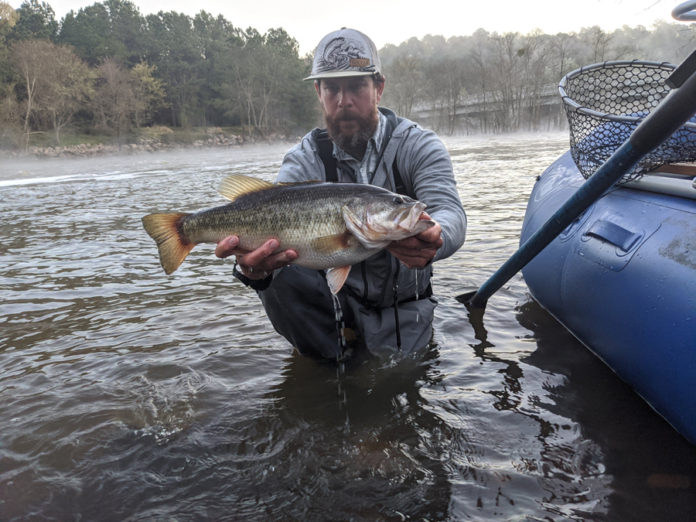Written by: EJ Stern, Raleigh Fly Fishing Guide Service
Largemouth bass are present in catchable numbers in every state but Alaska, and they are the primary drivers of the multi-billion-dollar fishing tackle industry. But the experience of fly-fishing for bucketmouths isn’t the same everywhere, so tactics that work in the Everglades, for instance, may not be the best choice for a Minnesota lake or a Texas river. (But then again, they just might.) To better understand regional differences in largemouth fishing, we’ve launched a series in which Orvis-endorsed guides explain how they tailor their tools and techniques to better fit local conditions. Hopefully this information will be useful not only for anglers in each region, but also for bass anglers across the country who are seeking a more comprehensive understanding of Micropterus salmoides.
This week, our focus is on North Carolina, where anglers can pursue largemouth bass within their native range every day of the year. We recently caught up with EJ Stern, owner/operator of Raleigh Fly Fishing Guide Service, who focuses mainly on rivers in the eastern part of the state when he’s chasing largemouth bass. He was kind enough to answer a few questions below:
1. What is the seasonal timing for largemouths in your region of North Carolina?
Largemouth bass can be caught year-round here, but on the rivers we fish–the Neuse, Tar, Haw, Eno, and Roanoke–our best time is from June through October. Spring presents some challenging fishing conditions: typically rain, high water, and of course the ever-present challenge of finding fish. However, understanding the conditions can produce some larger pre-spawn fish that have moved upriver, pursuing migratory schools of gizzard shad and herring. Casting large baitfish streamers can yield some pleasant surprises.
Spawning time is different in each river and varies depending on the specific region, but generally occurs in May or early June. Weather conditions, water temperature, and river flow are all factors. Post-spawn and into summer is our best time of year, with consistent water flows, weather, and the fish feeding in typical haunts. Peak summer feeding times can be during the hottest part of the day and into evening, while late-summer heat waves limit feeding to early mornings and late evenings. During early fall, when water temperatures begin to cool, the fishing improves. Winter fishing is difficult, with largemouth bass becoming lethargic. To increase your odds, fish on warmer days, using “slow and low” tactics with streamers and jiggy flies.

2. What are some of your favorite fly patterns or variants?
Our favorite topwater bugs include Deer Hair Frog, Bass Bug, Goodale’s Popper, and Howitzer Popper. When we are fishing subsurface, we use streamers such as Schmidt’s Double Deceiver, Galloup’s Bangtail T&A, Dally’s Tiny Dancer, and Kraft’s Kreelex.
3. Describe some of your most productive techniques or approaches.
We use rafts to float on shallow, slow-moving rivers, prospecting around sunken timber, cutbanks, and around grassy points. When popper fishing, we use a consistent pop-and-pause retrieve for 3 cycles, and then throw in a long pause that will often get fish looking up and ready to ambush. When streamer fishing, we use hard strips and abrupt stops, letting the fly suspend or the tail kick to entice strikes.
Credit: Source link































